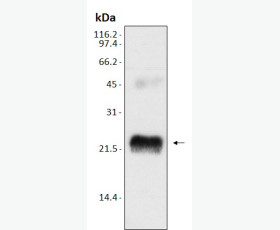Recombinant Human Kallikrein 7/KLK7/SCEE
| Product name: | Recombinant Human Kallikrein 7/KLK7/SCEE |
| Source: | Human Cells |
| Purity: | Greater than 95% as determined by reducing SDS-PAGE. |
| Buffer Formulation: | Supplied as a 0.2 μm filtered solution of 20mM HEPES, 150mM NaCl, pH 7.5. |
| Applications: | Applications:SDS-PAGE; WB; ELISA; IP. |
| Storage: | Avoid repeated freeze/thaw cycles. Store at 2-8 oC for one month. Aliquot and store at -80 oC for 12 months. |
| UOM: | 100ug/50ug/200ug/1mg/1g |
| Source | Human Cells |
| Description | Recombinant Human Kallikrein 7 is produced by our Mammalian expression system and the target gene encoding Glu23-His252 is expressed with a 6His tag at the C-terminus. |
| Names | Kallikrein-7, hK7, Serine Protease 6, Stratum Corneum Chymotryptic Enzyme, hSCCE, KLK7, PRSS6, SCCE |
| Accession # | P49862 |
| Formulation | Supplied as a 0.2 μm filtered solution of 20mM HEPES, 150mM NaCl, pH 7.5. |
| Shipping |
The product is shipped on dry ice/ice packs. |
| Storage |
Store at < -20°C, stable for 6 months after receipt. Please minimize freeze-thaw cycles. |
| Purity |
Greater than 95% as determined by reducing SDS-PAGE. |
| Endotoxin | Less than 0.1 ng/µg (1 IEU/µg) as determined by LAL test. |
| Amino Acid Sequence |
EEAQGDKIIDGAPCARGSHPWQVALLSGNQLHCGGVLVNERWVLTAAHCKMNEYTVHLGSDTLGD RRAQRIKASKSFRHPGYSTQTHVNDLMLVKLNSQARLSSMVKKVRLPSRCEPPGTTCTVSGWGTT TSPDVTFPSDLMCVDVKLISPQDCTKVYKDLLENSMLCAGIPDSKKNACNGDSGGPLVCRGTLQG LVSWGTFPWGQPNDPGVYTQVCKFTKWINDTMKKHVDHHHHHH
|
| Background | Human Kallikrein 7 is a member of the tissue kallikrein family of extracellular serine proteases that is made up of 15 members. It is predominantly expressed in the skin. A major physiological function of Kallikrein 7 is to regulate the desquamation process (the shedding of corneocytes from the outer layer of the epidermis) through proteolysis of the intercellular adhesive structures between corneocytes. Dysregulation of Kallikrein 7 has been linked to several inflammatory skin diseases including atopic dermatitis, psoriasis, and Netherton syndrome. Studies have shown that Kallikrein 5 is a potential physiological activator for Kallikrein 7. The proform of Kallikrein 7 can be activated by thermolysin. |














